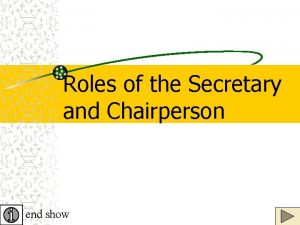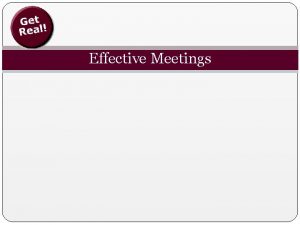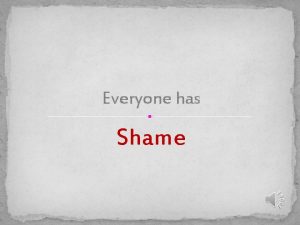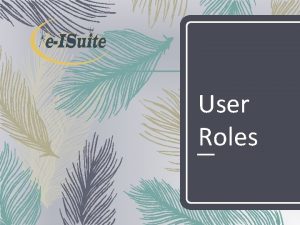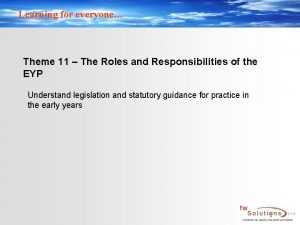Learning for everyone Meeting types and the roles











- Slides: 11

Learning for everyone… Meeting types and the roles involved Business Administration: Level 3 Unit 4: Principles of Business Administration ( LO’s 3 and 4)

Learning for everyone… Aims and Objectives Learning Outcome 3: Learning Outcome 4: Understand how to take minutes Understand how to chair, lead and of meetings. manage meetings. We will look at the purpose of We will look at the features and meeting minutes, the implications of these and the need for accuracy when producing minutes purpose of different types of meetings, look at and explain the role of the chair and explain the requirements of a meeting both before and after the meeting

Learning for everyone… What are meetings? Ø What are Meetings? Ø A meeting is a gathering of two or more people. Ø Meetings are convened for the purpose of achieving a common goal through verbal interaction, such as sharing information or reaching agreement. Ø A meeting is typically headed by a chairperson, and its deliberations are recorded in a written form called minutes.

Learning for everyone… Types of meetings What are the types of Meetings? Ø Formal Ø Informal Formal meetings: formal meetings are also known as: Ø board meetings or stockholders meeting Ø committee meetings or council meeting Ø caucus or conclave meetings Ø Congress or summit meetings of a symposium. Informal meetings: An informal meeting can also be know as: Ø one to one or team meeting

Learning for everyone… Roles and responsibilities The four basic meeting roles present within any meeting are: Ø Chairperson: determines the meeting objectives and plans, and is responsible for the overall direction of the meeting. Ø Facilitator: manages how people work together in the meeting, helps meeting participants clear up conflicts, and solve problems quickly. Ø Recorder: keeps track of the vital information from the meeting and keeping it visual, makes sure the information is accurate, and helps to distribute it among participants (Minute taker) Ø Participants: a group of individuals with a variety of skills, talents, and personalities; responsible for getting the job done, generate ideas, analyse information, make decisions, and implement action plans.

Learning for everyone… What are meeting minutes? Ø Meeting minutes are the written or recorded documentation used to inform attendees and non attendees about what was openly discussed Ø Meeting minutes are generally taken or recorded during the meeting so that participants have a record of what happened during the meeting. Ø Minutes usually include: • • • the names of the participants, the agenda items covered, decisions made by the participants, the follow-up actions committed to by participants, due dates for the completion of commitments, and any other events or discussions worth documenting for future review or history

Learning for everyone… What Are the Requirements of a Meeting Note Taker? To: Ø Record accurately the decisions, commitments and major decisions made during the meeting. Ø Record the action items that meeting members committed to doing along with the due date that members committed to making. Ø Ensure all action items have a name attached, but the general discussion does not state who said what in informal workplace meetings.

Learning for everyone… Legal Obligations Ø Minutes serve as the official record of the actions that occurred at a meeting and serve as a historical record. Ø Minutes should be kept at all board meetings and general meetings. Ø Minutes may be one way you maintain the protection from individual liability for your officers that incorporation provides. Ø For organisational purposes, you might want to keep minutes at committee meetings, as well. Ø As a general rule, keep minutes at any type of meeting where people may vote.

Learning for everyone… What to include? Minutes should include four basic types of information: Ø Time, date, and location of the meeting. Ø The fact that proper prior notice of the meeting was given (Agenda) to those attending the meeting. Ø Who was in attendance (names of board members or the approximate number of people attending) and whether a quorum was present. Ø The official actions taken by the meeting participants (motions made and approved or defeated).

Learning for everyone… Jargon Buster Agenda – An agenda sets out the structure of the meeting. Minutes – Minutes are a formal record of the events which occur during a meeting. Chairperson – The chairperson is in charge of the meeting and decides who can speak and when. Quorum – This refers to the minimum number of people required for the meeting to remain valid.

Learning for everyone… Mock test…. Ø Link: http: //www. contentextra. com/btecapprenticeshipworkbooks/files/busadminl 3 learnnew/quadquizzes/79104_ba_ba 3_q_u 4/basedesktop/index. html OR - Paper mock test
 What is meeting and types of meeting
What is meeting and types of meeting What is meeting and types of meeting
What is meeting and types of meeting Hello everyone today
Hello everyone today Roles of a secretary before a meeting
Roles of a secretary before a meeting Roles in a meeting
Roles in a meeting For today's meeting
For today's meeting Today meeting or today's meeting
Today meeting or today's meeting Cuadro comparativo e-learning y b-learning
Cuadro comparativo e-learning y b-learning Motivated learning for everyone
Motivated learning for everyone Early learning for everyone
Early learning for everyone Early learning for everyone
Early learning for everyone Early learning for everyone
Early learning for everyone



